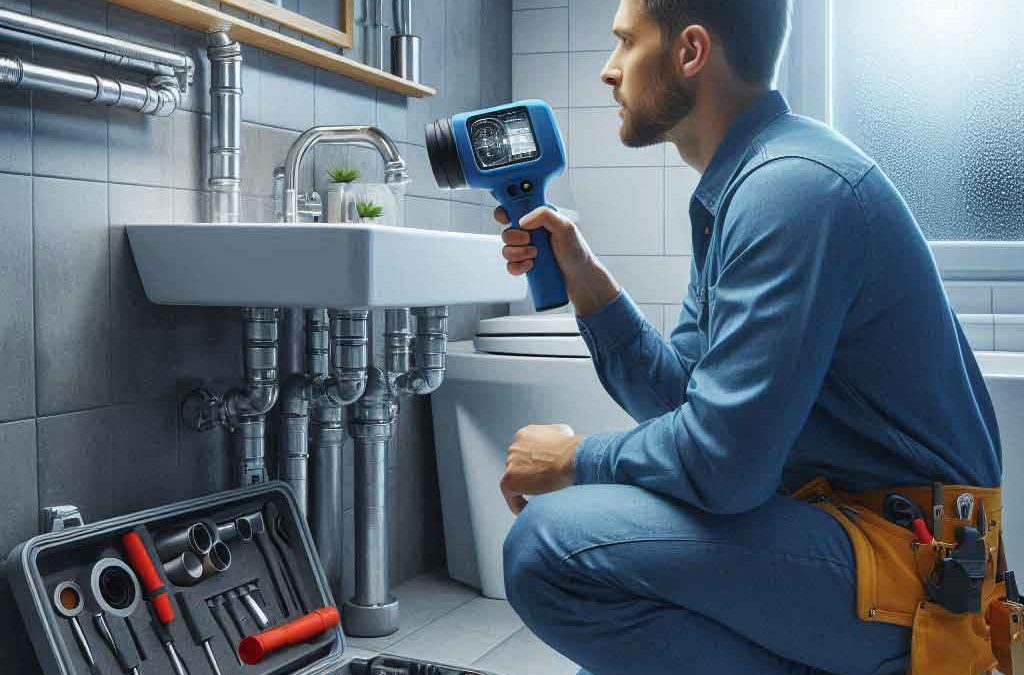Bathroom water leakage can be detected in different way by checking bathroom fixtures, flush leaks, checking walls and floors for peeling paint etc. For your convenient, we have covered some basic steps which will help you finding the leak easily, and if you still doesn’t found the leak please contact us and we will find the leaks to reduce your high water bills.
Inspect the Bathroom Fixtures
The first step in checking for water leakage in the bathroom is to inspect the fixtures. Faucets, showerheads, and sink pipes are common sources of leaks. Turn on the water and observe if there are any visible drips when the fixture is turned off. Even a small leak can result in a higher water bill over time. Also, check around the base of faucets and handles for moisture or discoloration, which may indicate slow leaks.
Examine the Toilet for Leaks
Toilets are a common culprit when it comes to water leakage in the bathroom. A silent leak in the toilet can waste gallons of water daily. To check for leaks, add a few drops of food coloring into the toilet tank and wait for about 15 minutes without flushing. If the color appears in the toilet bowl, there is a leak that needs to be addressed. Additionally, inspect the area around the toilet base for water pooling or dampness, which could suggest a faulty wax ring seal.
Check the Walls and Flooring
Bathroom leaks can sometimes be hidden behind walls or beneath the flooring. If you notice peeling paint, bubbling wallpaper, or water stains on the walls, it could be a sign of a concealed leak. Soft or warped flooring near the bathtub, toilet, or sink is another indication of water damage. Touch the walls and floors to feel for damp spots, and investigate any musty odors that could signal mold growth due to excess moisture.
Inspect the Shower and Bathtub
Cracks in the bathtub or gaps in the caulking around the shower can allow water to seep into walls and floors, leading to hidden leaks. Run water in the tub or shower and watch for any pooling around the base. Ensure that the grout and caulking are intact, as worn-out seals can let water escape. If water drains unusually slowly, it might indicate a hidden leak affecting the plumbing system.
High DEWA Bills
Sudden increase in DEWA bills is also a sign of unnoticed water leakage. The process is pretty simple and also very common, close all the water fixtures and note down the meter reading and wait for an hour. After an hour check the meter reading again, if the current meter reading exceeds then you must take a closer look at all the possible places to find the leakage or you can also call Leak-Plus.com to find you a leak.
Check for Mold and Mildew Growth
Persistent mold and mildew in the bathroom, especially in areas that are not directly exposed to water, may signal a hidden leak. Mold thrives in damp, dark places, so any unexpected growth on walls, ceilings, or cabinets should be investigated further. If you detect a musty smell that doesn’t go away, it may be due to excess moisture from a leak behind the walls or under the sink.
Conclusion
Bathroom leak detection is crucial for maintaining a safe and dry living space. Regularly inspecting fixtures, walls, floors, and plumbing systems can help you identify potential leaks before they cause extensive damage. If you suspect a hidden leak, consider consulting a professional plumber to conduct a thorough inspection. Timely detection and repair can save money on water bills and prevent costly structural repairs in the long run.
🚿 Detect & Fix Bathroom Leaks Before They Cause Damage!
Hidden leaks can lead to costly repairs! Our expert bathroom leak detection service finds the problem fast—saving you time, money, and stress. Don’t wait for water damage—schedule your inspection today!


Recent Comments